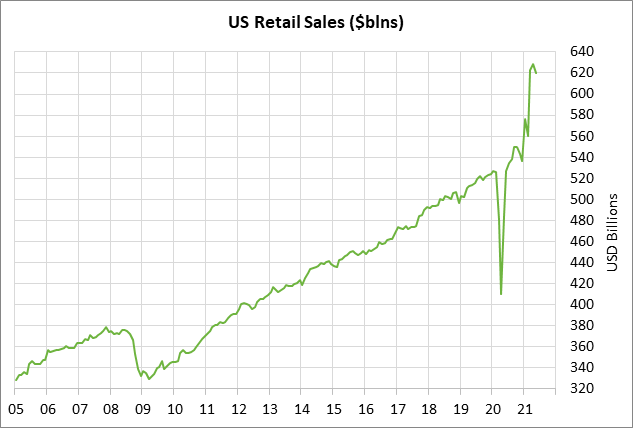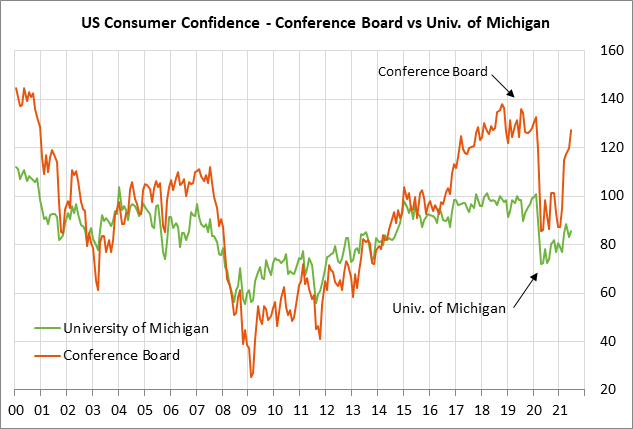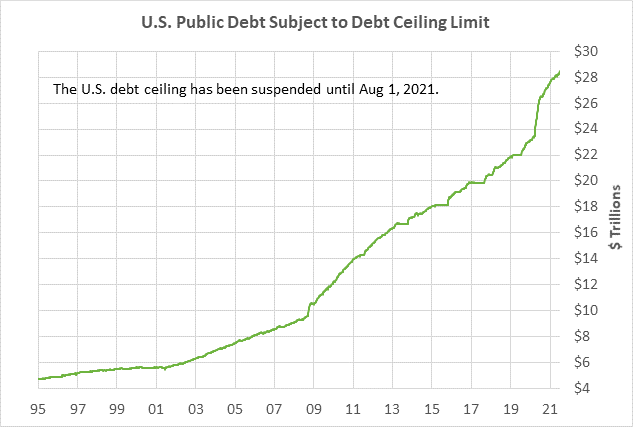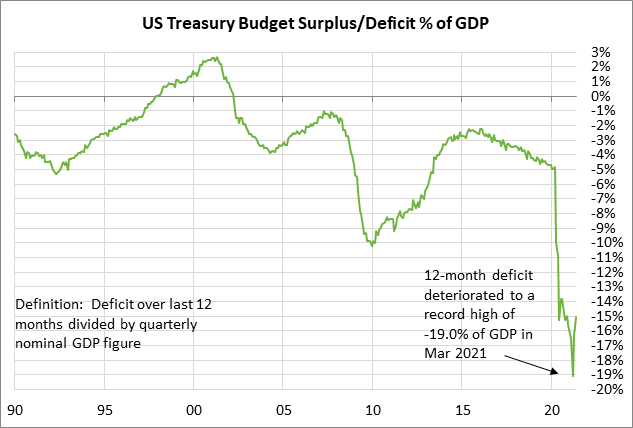- U.S. retail sales expected to fade as help from stimulus checks runs out
- U.S. consumer sentiment index expected to show a small increase
- Senate infrastructure legislation to move forward next week
U.S. retail sales expected to fade as help from stimulus checks runs out — The consensus is for today’s June retail sales report to fall -0.4% m/m. However, the weakness is expected to stem mainly from auto sales since retail sales ex-auto sales are expected to show a modest increase of +0.4%. In May, retail sales were weak and fell by -1.3% m/m and ex-auto retail sales fell -0.7% m/m.
Retail sales have tapered off since March, when sales surged by +11.3% m/m due to the distribution of government stimulus checks. However, retail sales remain generally strong since most consumers are in solid financial shape after having saved cash during the pandemic when the travel, restaurant, and entertainment sectors were mostly closed.

U.S. consumer sentiment index expected to show a small increase — The consensus is for today’s preliminary-July University of Michigan U.S. consumer sentiment index to show a +1.0 point increase to 86.5, adding to June’s +2.6 point increase to 85.5.
The U.S. consumer sentiment index has recovered moderately from last year’s pandemic low, but has only recovered about half of the plunge seen last year due to the pandemic. The current sentiment index level of 85.5 is still -15.5 points below the pre-pandemic level of 101.0 seen in February 2020.
Consumers are encouraged by the reduced Covid infection numbers and the economic recovery. However, the Covid delta variant has recently pushed the infection figures mildly higher and is causing concerns that the pandemic will persist. Some consumers also remain concerned about the labor market since the U.S. economy is still down by 6.7 million jobs from the pre-pandemic levels.
High gasoline prices are another negative factor for consumer sentiment. The nationwide average price of regular gasoline is currently at a 6-3/4 year high of $3.155 per gallon, according to AAA.
Consumers are being forced to use a larger portion of their disposable income to buy gasoline that has become more expensive due to the success of the OPEC+ cartel in restricting oil production and pushing oil and gasoline prices higher.


Senate infrastructure legislation to move forward next week — Senate Majority Leader Schumer on Thursday announced that he intends to hold a test vote next Wednesday on the bipartisan infrastructure plan.
The Senate is only scheduled to be in session for another three weeks before leaving on August 9 for its summer recess. The Senate will then be on recess until September 13.
Mr. Schumer is pushing hard to get a vote on the bipartisan infrastructure bill and the $3.5 trillion Democratic budget resolution before leaving for the August recess. However, neither bill is ready.
Senators next Wednesday will be called upon to vote on an infrastructure shelf bill that may not contain all the details of the $579 billion bipartisan infrastructure plan, which will make it even harder to attract the 60 votes necessary to avoid a filibuster.
In addition, the bipartisan plan ran into trouble on Thursday when Senators dropped the idea of spending $40 billion on the IRS to get $100 billion more in revenue. The bipartisan group of Senators now face the difficult problem of trying to replace a $100 billion pay-for.
Mr. Schumer is trying to get the bipartisan group to either put-up or shut-up about their bill and avoid allowing the negotiations to be drawn out any further. If the bipartisan bill cannot get past a Republican filibuster, then Democrats will roll the infrastructure measures into their $3.5 trillion social spending bill.
Meanwhile, the House this Monday will return from its Fourth of July recess. The House passed an infrastructure bill before leaving for its Fourth of July recess, which will be introduced into the Senate on Monday as a legislative vehicle for a Senate infrastructure bill.
House Speaker Pelosi has said that the House will not vote on any bipartisan Senate infrastructure bill before the Senate has also passed the $3.5 trillion social spending bill. The House is therefore in a wait-and-see mode as the legislative gears in the Senate grind slowly forward.
The debt ceiling will gain increased attention in the next few weeks since the debt ceiling will be reinstated in about two weeks on July 30. The Treasury will then be forced to use emergency procedures to conserve cash. However, the Treasury will eventually run out of cash and will have no legal authority to borrow more money, meaning the Treasury will then hit its “X-Date” when it starts to default on its obligations, possibly including a sovereign default on Treasury security debt.
The Bipartisan Policy Center has warned that it will be particularly difficult to predict the X-date this time around because of “the high uncertainty of Treasury Department cash flows relating to COVID-19 relief disbursements and the pace of the economic recovery.” The BPC is predicting an X-day sometime “this fall,” after the new fiscal year begins on October 1. That means that Congress will likely include a debt ceiling hike with the new fiscal-year spending bill that will be necessary to keep the government open past Oct 1.


